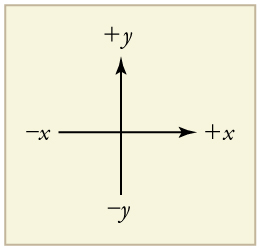Chapter 2: Describing Movement in One Dimension, 1-D Linear Kinematics
2.2 Vectors, Scalars, and Coordinate Systems
Authors: Paul Peter Urone, Roger Hinrichs
Adapted by: Rob Pryce, Alix Blacklin
Learning Objectives
By the end of this section, you will be able to:
- Define and distinguish between scalar and vector quantities.
- Assign a coordinate system for a scenario involving one-dimensional motion.

What is the difference between distance and displacement? Whereas displacement is defined by both direction and magnitude, distance is defined only by magnitude. Displacement is an example of a vector quantity. Distance is an example of a scalar quantity. A vector is any quantity with both magnitude and direction. Other examples of vectors include a velocity of 90 km/h East and a force of 500 Newtons straight down.
The direction of a vector in one-dimensional motion is most often given simply by a plus (+) or minus (-) sign. The direction of vectors can also be indicated descriptively, using words such as ‘up’, ‘left’, or ‘Wast’.
Vectors can also be are represented graphically by arrows. When representing vectors with arrows, the length of the arrow is proportional to the vector’s magnitude (e.g., the larger the magnitude, the longer the length of the vector) and the arrow points in the direction of the vector.
Some physical quantities, like distance, either have no direction or none is specified. A scalar is any quantity that has a magnitude, but no direction. For example, height (1.8m), body mass (80 kg), energy (250 Calories), and a running pace of 8:00min/km are all scalars—quantities with no specified direction. Note, however, that in some cases a scalar can be negative, such as a -20C temperature. In this case, the minus sign indicates a point on a scale rather than a direction. Scalars are never represented by arrows.
Coordinate Systems for One-Dimensional Motion
In order to describe the direction of a vector quantity, you must designate a coordinate system within the reference frame. For one-dimensional motion, this is a simple coordinate system consisting of a one-dimensional coordinate line. In general, when describing horizontal motion, motion to the right is usually considered positive, and motion to the left is considered negative. With vertical motion, motion up is usually positive and motion down is negative. In some cases, however, it can be more convenient to switch the positive and negative directions. For example, if people in a race are running to the left, it might be useful to define left as the positive direction. It does not matter as long as the system is clear and consistent. Once you assign a positive direction and start solving a problem, you cannot change it. In the next chapter we will learn how to work with vectors in two-dimensions.

Check your Understanding
A person’s speed can stay the same as he or she rounds a corner and changes direction. Given this information, is speed a scalar or a vector quantity? Explain.
Solution
Speed is a scalar quantity. It does not change at all with direction changes; therefore, it has magnitude only. If it were a vector quantity, it would change as direction changes (even if its magnitude remained constant).

